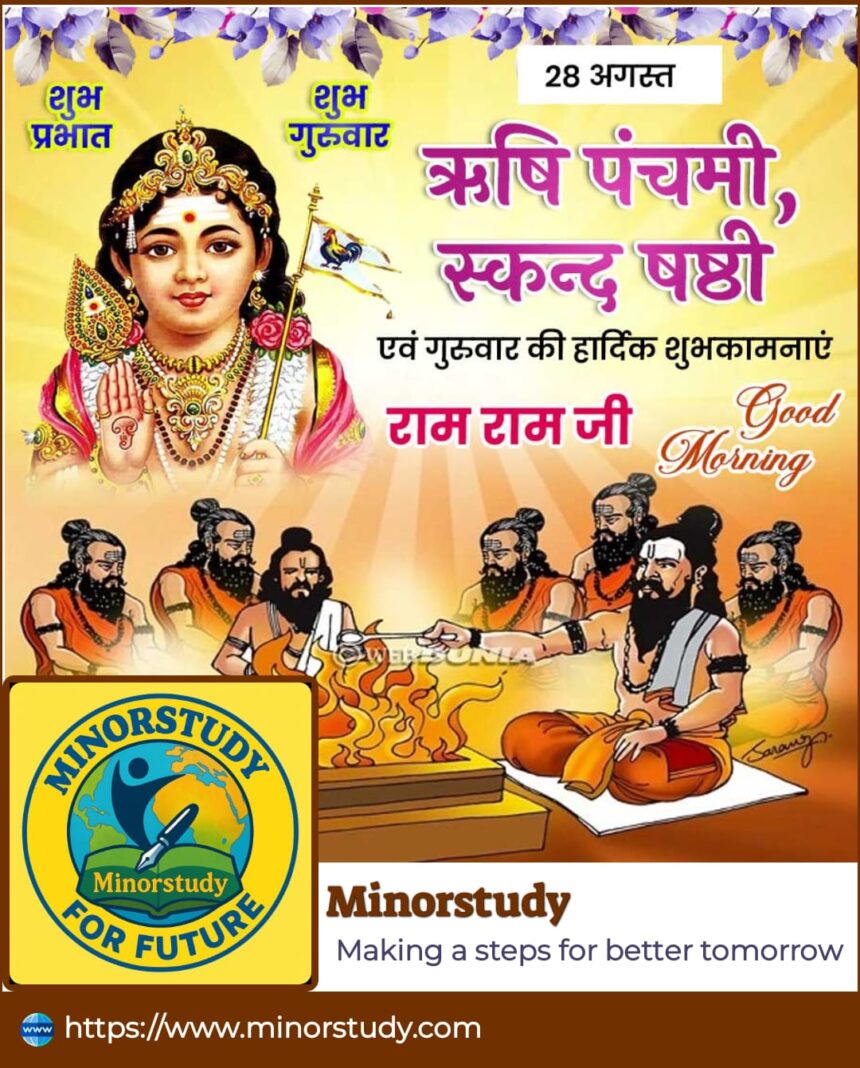Introduction
India, the land of festivals, traditions, and spirituality, is blessed with countless occasions that celebrate divinity, gratitude, penance, and the eternal connection between humans and the cosmos. Among these sacred observances, Rishi Panchami and Skanda Shashthi hold a very special place.
- Introduction
- 🌿 What is Rishi Panchami?
- 🪔 What is Skanda Shashthi?
- 🏛️ History of Rishi Panchami
- ⚔️ History of Skanda Shashthi
- 📜 Timeline of These Festivals
- ✅ Significance of Rishi Panchami
- ✅ Significance of Skanda Shashthi
- 🌍 Daily Life Impacts
- 📊 Interesting Facts
- 🙏 How Are They Observed?
- 💌 Wishing Messages
- 📌 Important Points
- ❓ FAQs
- 🏆 Importance to Society
- 📝 Conclusion
While Rishi Panchami is observed to honor the Saptarishis (Seven Sages) and to cleanse one’s sins through fasting and prayers, Skanda Shashthi is dedicated to Lord Skanda (Kartikeya), the son of Lord Shiva and Goddess Parvati, who is regarded as the warrior god who defeated demonic forces.
Both these festivals may seem different in nature—one emphasizes penance and purity, while the other celebrates victory, courage, and devotion—but together, they teach us how spirituality impacts our daily life, personal growth, family harmony, and social values.
In this article, we’ll explore the history, facts, timeline, significance, observance, FAQs, and real-life impact of these two festivals. You’ll also find wishes and messages you can share with your loved ones, and insights into why these observances are not just rituals, but powerful practices that enrich our modern lives.
🌿 What is Rishi Panchami?
Rishi Panchami is celebrated on the fifth day (Panchami) of Shukla Paksha in the Bhadrapada month (August–September). It is primarily observed by women, though men also keep the fast in some traditions.
It is believed that observing Rishi Panchami Vrat helps in washing away the sins caused knowingly or unknowingly, especially those related to breaking purity rules during menstruation as per ancient traditions.
The day is dedicated to the Saptarishis – Kashyapa, Atri, Bharadwaja, Vishwamitra, Gautama, Jamadagni, and Vashistha. Women observe fasts, offer prayers, and take ritual baths in rivers or ponds to purify themselves.
🪔 What is Skanda Shashthi?
Skanda Shashthi (also known as Kartikeya Shashthi) is celebrated on the sixth day of the waxing phase of the moon (Shukla Paksha) every month, but the most significant observance falls in the month of Kartik (October–November).
The day marks the victory of Lord Skanda (Murugan or Subramanya) over the demon Tarakasura. Devotees observe fasting, visit temples, and chant hymns like the Skanda Shashti Kavacham for blessings of courage, protection, and wisdom.
In Tamil Nadu, Kerala, and Sri Lanka, Skanda Shashthi is celebrated with great enthusiasm, especially at Tiruchendur Murugan Temple, where a dramatic reenactment of the battle between Skanda and Tarakasura takes place.
🏛️ History of Rishi Panchami
The history of Rishi Panchami goes back to ancient times when Sage Vedavyasa narrated its importance in the Bhavishya Purana. According to legend:
A Brahmin named Utanka and his wife once had a daughter who suffered from several health issues.
The family consulted sages who explained that the girl was suffering due to sins of neglecting menstrual rules of purity in her previous birth.
Observing Rishi Panchami Vrat with devotion helped her attain purity and peace.
Thus, the tradition evolved where women observe this vrat to cleanse themselves spiritually and physically while expressing gratitude to the Saptarishis for guiding humanity.
⚔️ History of Skanda Shashthi
The Skanda Purana and various Tamil scriptures narrate the story of Skanda’s birth and his battle with Tarakasura.
Tarakasura, a mighty demon, obtained a boon that he could only be defeated by the son of Lord Shiva.
Since Lord Shiva was lost in meditation after Goddess Sati’s sacrifice, the gods worried about the growing terror of Tarakasura.
Finally, through divine intervention, Lord Shiva and Goddess Parvati gave birth to Kartikeya (Skanda), a warrior with six faces (Shanmukha).
Skanda led the army of gods and defeated Tarakasura on Shashthi tithi, marking the triumph of dharma (righteousness) over adharma (evil).
This victory is celebrated as Skanda Shashthi, particularly in South India, where Kartikeya is revered as the supreme commander of divine forces.
📜 Timeline of These Festivals
Vedic Era (1500–500 BCE): Mention of sages (Rishis) and their guidance in Rigveda, which later connects to Rishi Panchami observance.
Puranic Age (400–1000 CE): Legends of Skanda, his birth, and the war against Tarakasura narrated in Skanda Purana and Tamil Sangam literature.
Medieval Period: Both festivals became community-driven events. Rishi Panchami emphasized women’s rituals, while Skanda Shashthi evolved into grand temple celebrations.
Modern Era: Still observed with devotion, though interpretations have evolved. Many see them as spiritual detox practices that blend tradition with modern relevance.
✅ Significance of Rishi Panchami
Purification of Body and Soul – Helps devotees overcome sins and negativity.
Respect for Women – Reminds society of honoring feminine energy.
Gratitude to Rishis – Acknowledges the contributions of sages in preserving Vedas and dharma.
Discipline in Life – Fasting teaches control over desires.
Spiritual Growth – Enhances devotion and inner strength.
✅ Significance of Skanda Shashthi
Victory of Good over Evil – Symbolizes the eternal triumph of righteousness.
Inspiration for Courage – Teaches us to face life’s challenges bravely.
Devotion and Discipline – Fasting brings mental clarity and focus.
Unity of Community – Grand celebrations bring people together.
Blessings of Protection – Devotees believe Kartikeya protects them from harm.
🌍 Daily Life Impacts
Rishi Panchami inspires people to live a disciplined, grateful, and pure life, respecting both men and women equally.
Skanda Shashthi motivates us to stand up against injustice, face adversities courageously, and nurture leadership qualities.
Both festivals remind us that spirituality is not about rituals alone, but about applying values in day-to-day life.
📊 Interesting Facts
Rishi Panchami is observed one day after Hartalika Teej.
Women performing Rishi Panchami often use Apamarga leaves (Achyranthes aspera) for prayers.
Skanda Shashthi is especially grand in Tamil Nadu, where devotees enact a Soorasamharam (slaying of demon Surapadman).
Lord Skanda is considered the commander-in-chief of the gods’ army.
Kartikeya is also worshipped as Murugan in Tamil Nadu, Subramanya in Karnataka, and Shanmukha in other regions.
🙏 How Are They Observed?
Rishi Panchami Observance:
Early morning bath in holy rivers or ponds.
Fasting with fruits or simple satvik food.
Worship of Saptarishis with flowers, turmeric, betel leaves, and lamps.
Reading or listening to Rishi Panchami Vrat Katha.
Skanda Shashthi Observance:
Fasting from sunrise to sunset.
Visiting Lord Murugan/Kartikeya temples.
Reciting Skanda Sashti Kavacham or hymns.
Attending Soorasamharam reenactments in temples.
💌 Wishing Messages
For Rishi Panchami:
“On Rishi Panchami, may the blessings of the Saptarishis purify your soul and guide you towards wisdom.”
“Wishing you a blessed Rishi Panchami filled with gratitude, devotion, and peace.”
For Skanda Shashthi:
“May Lord Skanda bless you with courage, wisdom, and victory over all difficulties. Happy Skanda Shashthi!”
“On Skanda Shashthi, may the warrior god protect you and your family with divine strength.”
📌 Important Points
Both festivals emphasize discipline, gratitude, and devotion.
Rishi Panchami focuses on purity and penance, while Skanda Shashthi emphasizes valor and victory.
They connect individuals to ancestral wisdom and divine protection.
In modern life, they serve as reminders of health, mindfulness, courage, and ethics.
❓ FAQs
Q1. Why is Rishi Panchami mainly observed by women?
Because ancient texts connect it with purification after menstrual impurity, but in modern times, it symbolizes overall spiritual cleansing, open for all.
Q2. Is fasting compulsory on Skanda Shashthi?
Not compulsory, but devotees observe it for mental discipline and blessings.
Q3. What is the difference between Skanda and Kartikeya?
They are the same deity, known by different names in different regions.
Q4. Can men observe Rishi Panchami fast?
Yes, though traditionally women observe it, men can also participate.
Q5. Why is Skanda Shashthi famous in Tamil Nadu?
Because Lord Murugan (Skanda) is the primary deity worshipped in Tamil tradition.
🏆 Importance to Society
Promotes cultural unity and spiritual bonding.
Encourages gender respect, discipline, and ethical living.
Strengthens community celebrations through festivals and rituals.
Inspires courage, leadership, and gratitude among youth.
📝 Conclusion
Rishi Panchami and Skanda Shashthi are not just religious observances, but timeless lessons for humanity.
One reminds us to stay pure, humble, and grateful to our sages, while the other inspires us to be brave, righteous, and devoted in the face of life’s struggles.
In a world filled with stress and uncertainty, these festivals give us hope, clarity, discipline, and inner strength. They remind us that spirituality is not about leaving the world but living within it with balance, courage, and gratitude.
So, this year when you observe Rishi Panchami or Skanda Shashthi, don’t just follow rituals. Instead, embrace their deeper meaning and apply their values in your daily life, family, and society—because that is where true devotion lies.









I like this site very much, Its a real nice position to read and obtain info . “The world breaks everyone, and afterward, many are strong at the broken places.” by Ernest Hemingway.